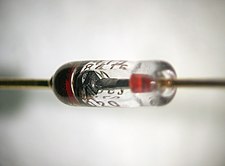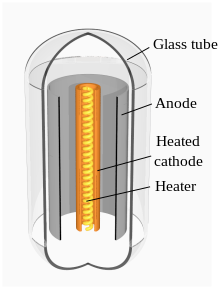
Back Diode Afrikaans Diode ALS ዳዮድ Amharic Diodo AN ثنائي المساري Arabic دايود ARZ ডায়ড Assamese Diodu AST Diod Azerbaijani دیود AZB
 Close-up view of a silicon diode. The anode is on the right side; the cathode is on the left side (where it is marked with a black band). The square silicon crystal can be seen between the two leads. | |
| Type | Passive |
|---|---|
| Pin configuration | Anode and cathode |
| Electronic symbol | |
 | |


A diode is a two-terminal electronic component that conducts current primarily in one direction (asymmetric conductance). It has low (ideally zero) resistance in one direction and high (ideally infinite) resistance in the other.
A semiconductor diode, the most commonly used type today, is a crystalline piece of semiconductor material with a p–n junction connected to two electrical terminals.[4] It has an exponential current–voltage characteristic. Semiconductor diodes were the first semiconductor electronic devices. The discovery of asymmetric electrical conduction across the contact between a crystalline mineral and a metal was made by German physicist Ferdinand Braun in 1874. Today, most diodes are made of silicon, but other semiconducting materials such as gallium arsenide and germanium are also used.[5]
The obsolete thermionic diode is a vacuum tube with two electrodes, a heated cathode and a plate, in which electrons can flow in only one direction, from cathode to plate.
Among many uses, diodes are found in rectifiers to convert alternating current (AC) power to direct current (DC), demodulation in radio receivers, and can even be used for logic or as temperature sensors. A common variant of a diode is a light-emitting diode, which is used as electric lighting and status indicators on electronic devices.
- ^ Tooley, Mike (2013). Electronic Circuits: Fundamentals and Applications, 3rd Ed. Routledge. p. 81. ISBN 978-1-136-40731-4.
- ^ Crecraft, Filip Mincic; Stephen Gergely (2002). Analog Electronics: Circuits, Systems and Signal Processing. Butterworth-Heinemann. p. 110. ISBN 0-7506-5095-8.
- ^ Horowitz, Paul; Winfield Hill (1989). The Art of Electronics, 2nd Ed. London: Cambridge University Press. p. 44. ISBN 0-521-37095-7.
- ^ "Physical Explanation – General Semiconductors". 2010-05-25. Retrieved 2010-08-06.
- ^ "The Constituents of Semiconductor Components". 2010-05-25. Archived from the original on 2011-07-10. Retrieved 2010-08-06.
© MMXXIII Rich X Search. We shall prevail. All rights reserved. Rich X Search